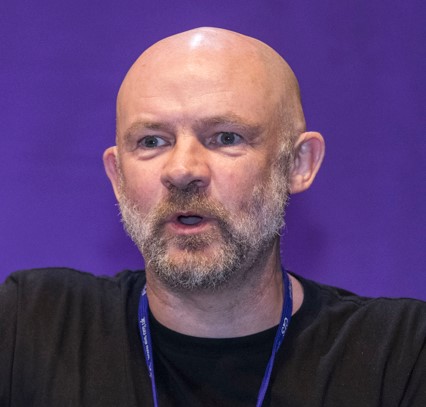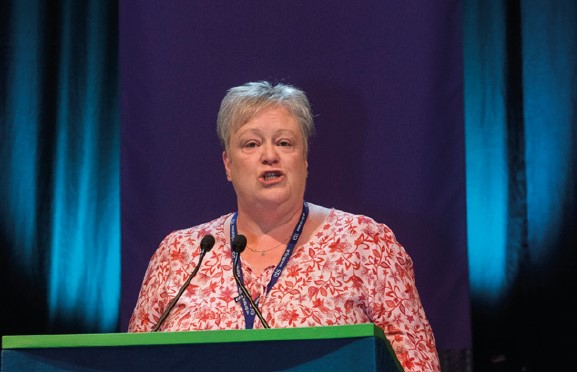
Why Every EIS Member Must Stand Up for Quality Education

Over four pages in the December issue of this magazine, the results of the EIS’ national survey laid bare the levels of violence being faced by learners and teachers in Scotland’s schools. I’m not going to go over the shocking figures again, but what I want to do is explain why this new campaign is everybody’s campaign and why every single EIS member in Scotland’s schools MUST Stand Up for Quality Education.
During the Pay Attention campaign, you told the EIS that whilst pay was a significant matter, you felt that workload was crippling, that it was nigh on impossible to properly support learners with Additional Support Needs and that violence and aggression in schools was getting out of hand.
The data gleaned from the violence and aggression survey shows that violence is endemic in schools in Scotland. It is safe to say that every one of you has either experienced or knows a colleague or friend who has experienced some form of violence and aggression in a school setting. For want of a better phrase, you have skin in the game. If you work at school with an EIS Rep, you will have access to an activist who can support you, but your rep can’t do everything, they need buy in and back up from members in their school. If your school does not have a rep that avenue of support is not quite so immediately open to you, but the EIS is still there. In both circumstances it is crucial that you report every incident of violence or aggression, that you support each other in your settings and that you demand full backing from school leaders and employers.
The EIS has your back, but it isn’t an outside organisation that steps in to help; your union is YOU. It is you and your colleagues coming together as one to support and empower each other as a collective in your school. And that is very powerful.
Adam Sutcliffe, Aberdeenshire Assistant LA Secretary
Supporting #SU4QE campaign activity in Inverclyde

Having received a breakdown of our local results in the national violence and aggression survey, a comparison paper was prepared and shared with school reps for members, our Head of Service, our Education lead in the Health and Safety team and our Education Officer (ASN).
An online meeting was held for school reps to discuss the results and possible next steps for our Local Association and school branches.
A Local Association Plan was developed and shared with reps. This has been updated and shared since then and will be regularly. The EIS locally met with H&S lead and EO to discuss the comparisons and to outline our ‘asks’.
The note of that meeting was shared with reps together with ‘How to’ guides for the reporting process and H&S Information Sheets to support those.
Working with reps, a Branch Plan template has been devised, agreed at Committee and is now with reps to use and adapt in their own setting. As well as an overview of what should be available to school staff and supporting information, that document also contains links to the relevant policy documents, information sheets and the reporting form. It’s a one-stop-shop should a violent or aggressive incident occur.
Our Head of Service will share that plan with HTs and Heads of Establishment so that there is a clear, shared message and it will go through LNCT in March to be formally ratified.
While all of that was going on, Dee Matthew, our Area Organiser, has been in touch with reps to offer branches support across all of this part of the Stand Up for Quality Education campaign and she has already been to several branch meetings and given advice to individual reps.
Our hope is that with everyone on the same planning page, with the shared messaging around expectations, protocols and processes and with communication being tightened up, we will see a shift towards recording being the norm which should result in a reduction in the incidences of violence and aggression that we are experiencing.
Paula McEwan, Inverclyde EIS Local Association Secretary & EIS National President
A campaign win in Moray on incident reporting

Moray moved to online recording in January 2023. The online form is completed and submitted centrally by the member of staff and then sent on to the line manager to complete. All information is collated centrally and analysed by a team which is lead by the QIO ASN.
Focus is given to those young people who have had over five unique violent and aggressive incidents and discussions held with the schools around the support that is in place. For pupils who are in an enhanced provision, support/advice is provided by the ASN team. For all other pupils, support/advice is provided by the central SEBN team.
For pupils with ten or more unique incidents, support is provided for the pupil and the school by a team of teachers and support staff from the central SEBN service.
ASN/SEBN is currently under review in Moray and sitting alongside that is a review of our current Violence and Aggression form and what can be done to improve it. The Violence and Aggression policy is also due to be reviewed to ensure that it is fit for purpose in line with the changes made to the reporting format. Moray have also committed to a full programme of training for staff to help develop their understanding of neurodiversity and behaviours of pupils with ASN.
Susan Slater, EIS LA Secretary for Moray
